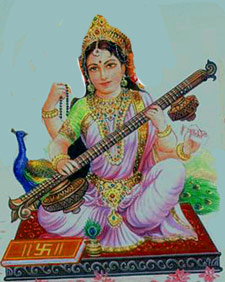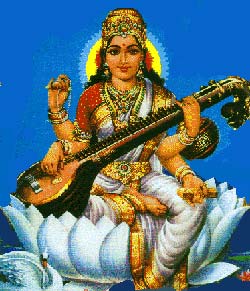|
Festivals of India
Basant Panchami
|
|||||
Basant Panchami, the end of winter and the beginning of spring, is when nature is in a state of joyous being. The ancient Hindu calendar started with this season. Basant Panchami or Sri Panchami is celebrated on the fifth day of Magha according to the lunar calendar, which is in Jan-Feb, was celebrated on 12th February in 2016, and is on 1st February in 2017. This day is dedicated to Sri Saraswati, Devi or Goddess of learning, knowledge and wisdom, known for her beauty, grace, discriminative wisdom and purity. She symbolises the union of power with intelligence and discrimination, from where purposeful creation begins. |
Festivals Of India • Radhasthami • Janamasthami • Festival Calendar • Ganesh Chaturthi • Nagpanchmi • Ramanavami • Diwali • MahaShivratri • Pilgrim Trails • Reflections • Sages & Saints | ||||
 Sri Saraswati, the goddess of wisdom, intellectual knowledge, fine arts and creativity, embodies the very wisdom of Devi. She is believed to inspire speech and the written word. She is the ever-flowing river of consciousness that is the Shakti of Creation. She is also Savitri the goddess of dawn who dispels the darkness of ignorance and lights the diya or lamp of Eternal Knowledge. In her absence, chaos and confusion prevail. To realize her, is to know the unchanging eternal serenity of the Spirit.
Sri Saraswati, the goddess of wisdom, intellectual knowledge, fine arts and creativity, embodies the very wisdom of Devi. She is believed to inspire speech and the written word. She is the ever-flowing river of consciousness that is the Shakti of Creation. She is also Savitri the goddess of dawn who dispels the darkness of ignorance and lights the diya or lamp of Eternal Knowledge. In her absence, chaos and confusion prevail. To realize her, is to know the unchanging eternal serenity of the Spirit.
In the explanation of how creation began, it is said that existence was in a formless, fluid state. Lord Brahma, the Creator recognised the need to transcend the mind and senses in creating form, and wondered, "How do I bring order to this chaos?" Then Sri Saraswati, whom Lord Brahma had created of his own mind, whose form eluded him continuously as he sought her in desire, said, "With knowledge." And so it came to be that Prajapati Brahma the creator, created yagya to instil harmony, peace and order in the manifest world. And from the cosmic sound of creation, came the Gayatri Mantra. Yagya was the father and Gayatri was the mother. Lord Brahma was the power and Sri Saraswati was the intelligence, He was the Creator and she was his Yog-Shakti. The Sanskrit word sara means essence and swa means self. Saraswati denotes the essence of the self. Saraswati is represented as the divine shakti of Lord Brahma, the Creator. Gyan or knowledge, imperishable, eternal is fundamental to creation, and Sri Saraswati symbolizes the creative power of Lord Brahma.
Om Saraswatiye Vidmahe Brahmaputriye Dhimahi Tanno Devi Prachodayat Usually depicted standing or seated on a fully blossomed white lotus, she is simplicity and beauty personified. Clad in white, she rides a white swan that symbolises Sattwa Guna or purity and discrimination. The lotus is a reminder of her being rooted in Supreme Reality with Supreme Knowledge at her command. Her smiling face of love and compassion is said to resemble the full moon. The absence of colour and ornamentation, other than the pearls of wisdom she wears, represents her rejection of the superfluous and her freedom from all but the very essence. The swan she chooses to use as her vahan or mount is the power of discrimination, the ability to separate milk from water. Sri Saraswati chooses the swan, implying the need for constancy, fearlessness, perfect discrimination to acquire knowledge of the Real. The peacock is depicted sitting beside her, waiting to serve Her. The peacock represents the arts that she patronises but is also is a reminder of the unpredictability of the mind, with its many moods, easily influenced.
According to Buddhist iconography she is depicted as the consort of Manjushri, the Boddhisattwa of Wisdom, an emanation of Vairochona, the Buddha Respendent, associated with the Sun at it's zenith or peak glory. The Boddhisatwa Manjushri is shown carrying the sword of discrimination to slay delusion and ignorance, and the sacred book of Wisdom. While Goddess Saraswati is widely worshipped in her individual capacity as the goddess of all knowledge and wisdom, relatively fewer people worship Sri Saraswati, the goddess of knowledge and refinement, along with her eternal consort Lord Brahma, in his aspect as Creator. Worship of Lord Brahma and Sri Saraswati is ideal for those who pursue knowledge, creativity and academic excellence in their lives, including students, artists and craftsmen, and those pursuing special talents and skills who seek inspiration, guidance and creativity. Those seeking spiritual progress through the Gyan (Jnana) Marg, worship them in their deep pursuit of knowledge and wisdom. The name Saraswati, has also been used among the Dashnami sannyasa tradition by Adi Shankaracharya. Among the ten different groups with varied ideologies and following particular philosophical paths which excel in their own philosophies, beliefs and practices, the order of Saraswati excel in Advaita, Vedanta and Yoga. When the fields ripple with the brilliance of mustard flowers, the festival of Basant Panchami is traditionally celebrated with an abundance of the colour yellow, in dress, festive decorations and offerings of sweets. This festival marks the beginning of the agricultural season. It is celebrated in different ways in different parts of India, both as an agricultural festival and dedicated to the goddess of learning. It is also celebrated as Shikshapatri Jayanti. Pandit Madan Mohan Malviya laid the foundations of the Kashi Hindu Vishwa Vidyalaya on Basant Panchami. It is known as Sirapanchami in Bihar and Orissa, and ploughs are worshipped and the land is furrowed after the winter months. In most parts of Garhwal, two types of ceremonies are performed: worship of mother earth, and worship of crops or agriculture. The land is ploughed, fertilised and made sacred with cowdung, ears of barley and wheat are placed in offering, earthen lamps are lit. Ears of corn and barley are also tied to doors and windows of houses and temples as an offering seeking abundance. In Bengal it is celebrated as Saraswati Puja, specially by students, academicians, educational and cultural institutions. Rabindranath Tagore organized cultural celebrations at Shantiniketan, which continue today, and have been popularised elsewhere among Bengalis, who have traditionally worshipped the goddess for the learning they seek. The day is considered particularly auspicious for initiation into the realm of knowledge. Accordingly, children are made to hold a pencil and led to form the first letter of the alphabet in symbolic initiation into academic learning. Customarily, students abstain from studying on this day. Books, inkpots, pens and all objects of writing and study are not used that day, but worshipped in veneration of the process of learning. Through ritual worship, we seek the blessings of those aspects of cosmic consciousness that are symbolised through a particular form or manifestation of the divine. We seek to activate that energy within ourselves that will fulfil the destiny we were born to complete.
|
|||||
Editor: Romola Butalia (c) India Travelogue. All rights reserved. |
|||||
 Her four arms denoting omnipresence and omnipotence, represent the four aspects involved in learning: manas or mind, buddhi or intellect, chitta or awareness and ahankar or ego. While there are variations in depiction according to the way the artist envisions her, she is generally shown holding the sacred scriptures in one hand, and a rosary in the other, symbolic of knowledge, spiritual wisdom, purity. With her other two hands she plays the music of life on her veena or stringed instrument. Her arms are representative of her perfect balance in the manifest world of physical activity while being ever immersed in spiritual Truth. The sacred book signifies that knowledge acquired should be used with love and compassion to promote universal welfare. The rosary symolises dharana or concentration and dhyana or contemplation and meditation, leading to samadhi, or One-ness. It conveys that discriminative knowledge, acquired through devotion, transcends the ego and results in enlightenment. The mind and intellect must be tuned to be in perfect harmony to live in the world.
Her four arms denoting omnipresence and omnipotence, represent the four aspects involved in learning: manas or mind, buddhi or intellect, chitta or awareness and ahankar or ego. While there are variations in depiction according to the way the artist envisions her, she is generally shown holding the sacred scriptures in one hand, and a rosary in the other, symbolic of knowledge, spiritual wisdom, purity. With her other two hands she plays the music of life on her veena or stringed instrument. Her arms are representative of her perfect balance in the manifest world of physical activity while being ever immersed in spiritual Truth. The sacred book signifies that knowledge acquired should be used with love and compassion to promote universal welfare. The rosary symolises dharana or concentration and dhyana or contemplation and meditation, leading to samadhi, or One-ness. It conveys that discriminative knowledge, acquired through devotion, transcends the ego and results in enlightenment. The mind and intellect must be tuned to be in perfect harmony to live in the world. 